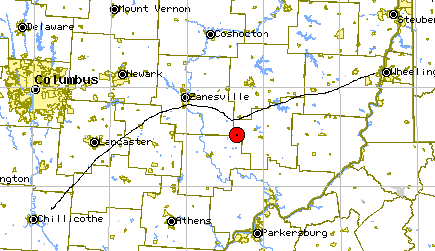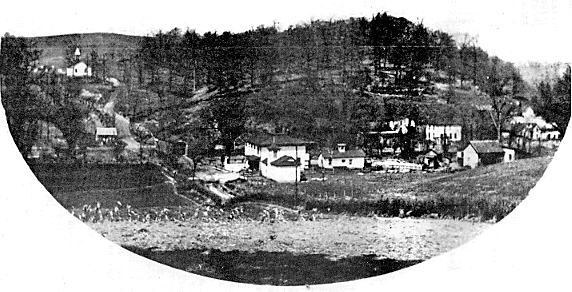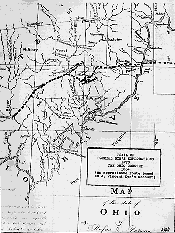 From Washington Co. came Allegheny, Beaver, and Greene Counties.]
From Washington Co. came Allegheny, Beaver, and Greene Counties.]
Ezekiel Dye Sr. - born 1753 and died on July 1, 1830 at an age of 77 years.
His first wife Elizabeth Cox died in Pa having reared 11 children. His second wife Sarah Egbert Paul died in 1844 having reared 9 children.
Ezekiel Dye was born in New Jersey. He was a Revolutionary soldier in the Battle of Monmouth under the command of General Dickinson. After the close of the war he married Elizabeth Cox and migrated to Westmoreland County , Pennsylvania, where his wife died after giving birth to 11 children. ]
[Washington Co. was formed from Westmoreland Co.  From Washington Co. came Allegheny, Beaver, and Greene Counties.]
From Washington Co. came Allegheny, Beaver, and Greene Counties.]
The Dye family was of pioneer stock and no one seems to be sure of their origin but it probably was English. Their eyes were steadily fixed on the future forgetting the past. This fact has made an incomplete record of their genealogy and renders a biography difficulty. We do know that the father of Ezekiel Dye, Sr. and Anthony Applegate married sisters (their maiden name is not known). Ezekiel Dye, Sr. was left an orphan and was reared by his uncle, Anthony Applegate.

There are several good resources on the Internet which provide background necessary to appreciate the conditions faced by Ezekiel Dye and his family as they moved westward.

Leaving this valley, they followed the St. Clair Trail to what is now Zanesville, and continued toward Chillicothe. Here they found marshes, water, and malaria. The stopped to compare notes and consider the best location for entering a land claim. They evidently decided they had come too far and had left the choice location behind.
Returning on the trail they stopped a quarter of a mile above the upper reaches of Dyes Fork of Meigs Creek and decided this was the place. Land values in those days were largely determined by the growth of oak, tulip tree called poplar), sugar maple, and black walnut "to the tops of the hills". A good source of spring water and well- drained land were also prime prerequisites.
Thus Ezekiel Dye, Sr., staked out 2500 acres of land for which he carried a deed from the U.S. Government. It was Congress Land given to Revolutionary soldiers in redemption for the money due them in pay for their services. The price was $1.25 per acre to those without any redemptions. They remained long enough to clear a four-acre tract and start a log house. This farm was later bequeathed to his daughter, Charlotte, who married John Moore and was until recently called "The John Moore Place". The Indians were not very troublesome except to steal what corn they wanted. The stood around while the clearing was being done, and would suddenly slip away. In one instance, Ezekiel was visited by two Indians. The saw them approaching and heard them muttering in their own language and by their looks and tones he concluded that they were not pleased by white man's intrusion. He feared that they might attack him and so he kept a firm grip on a hand spike with which he was at work until his visitors departed. He fully intended to use it over their heads in case of a hostile demonstration.
After staking out his land, the party returned to Westmorland County Pa. Shortly after this Ezekiel's wife died and she was buried in that county. In 1806 Ezekiel sent his six oldest sons to prepare the Ohio land claim for the remainder of the family. These six sons were Thomas, Ezekiel Jr., Vincent, William, John, and Amos. (Ezekiel was a common name used by the Dyes. It was often shortened to "Zeke".) Thomas was married and his wife gave birth to the first-born child in Brookfield Twp.; namely, Benjamin Dye, born in 1810. Ezekiel married again to a widow, Sarah Egbert Paul. They reared a family of 9.
 In 1807 Ezekiel
made his final move from Pa., to his new land in the Ohio country along with some of his
daughters. Thomas and Ezekiel both lived on a farm south of the new cemetary
until it was sold to John K. Reed.
In 1807 Ezekiel
made his final move from Pa., to his new land in the Ohio country along with some of his
daughters. Thomas and Ezekiel both lived on a farm south of the new cemetary
until it was sold to John K. Reed.
Ezekiel Sr. was a deeply religious man, - a devout Baptist. The last day of his life he and two or three of his boys were out on the farm by a hickory tree that stood just below the bridge. He looked at the ripening wheat across the road and remarked, "Boys, the wheat is ready for the sickle." He became faint. The boys took him to the house but he never spoke again.
Tradition informs us that when Ezekiel Dye, Sr. emigrated from Westmorland Co., that four of his brothers left there the same year. Ezekiel, as we have stated settled on what is now Dyes Fork of Meigs Creek, another in Marietta (the Washington County relatives of John Dye Sr., Ezekiel Dye Sr. oldest brother), one in West Virginia (John Dye, son of Amos Dye and Ruben Dye, son of Vincent Dye), and another in Vinton County (Henry Dye, the grandson of Amos Dye and Ezekiel's grand nephew). The various generations have multiplied and spread to virtually every state in the union too numerous to be traced.
J. Vincent Dye.
The town of Renrock, Ohio has a most interesting history. I would welcome any additions, corrections, and review of the material that has been assembled to date.